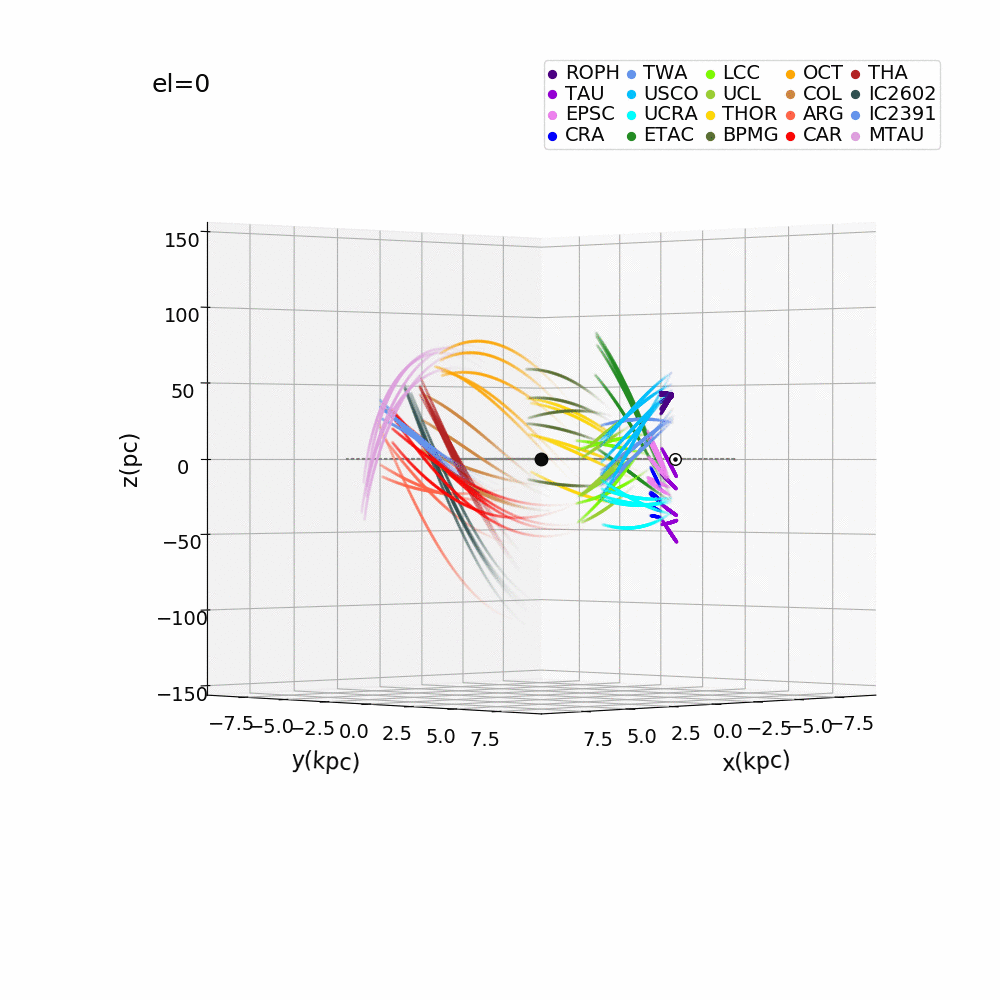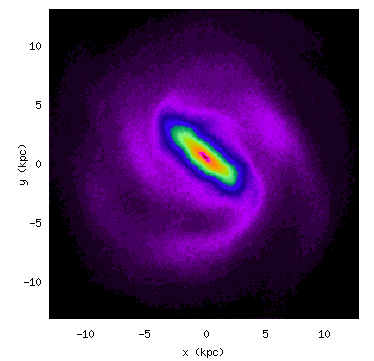Birth Sites of Young Stellar Associations; Recent Star Formation in a Flocculent Corrugated Disk (in MNRAS; ADS) , (arxiv)

Above is an animated 3D figure showing backwards integrated orbits of young stellar associations.
Click on this image to see a movie showing an orbit that grazes a spiral arm

Click here for movie of tracer particles being perturbed by spiral structure (on the shearing sheet)!

Illustrating how a cluster turns into a stream and then dissolves. youtube video
Click here for a movie!

Inspired by the recent discovery of a X- or peanut shape to our Galaxy bulge, I re-examined the strength of the 2:1 vertical resonance (2 vertical oscillations per rotation in the bar frame). I was surprised to find that the vertical resonance in simulations is quite narrow and is drifting outwards in the simulations. This implied that my old resonance capture model needed correction. The new model is a resonance heating model : Stars in the midplane, as they enter the resonance, are lifted to high inclinations to orbits just inside the resonance separatrix, distant from the banana shaped periodic orbits but supporting the peanut shape rotating with the bar. The X-shape arises from the shape of orbits of the few stars that are currently in or near resonance. Stars exterior to resonance would not support the peanut shape. The X-shape stars would have metallicities like the disk exterior to the resonance. The Hamiltonian model can be used to place constraints on the mass distribution in the central 1.5 kpc of the Milky Way Galaxy.
Talk given at CITA Oct 2013 pptx
Below are two movies of N-body simulations, one showing a bar that buckles (on left), the other without buckling (on right). These movies show face-on and edge-on views of barred galaxies. Both movies show that the peanut shape becomes more extended as the bar slows down.
Quicktime 7 movies:
Mp4 movies:

|

|
| galaxy disk in Cartesian coordinates | galaxy disk in polar coordinates |
The first of these movies is pretty ordinary (except for Jamie's garish color scheme). The second of these movies presents a polar view of spiral structure. At the time we had never seen an animated polar view of an N-body spiral disk, but lately other groups have been presenting them for similar reasons; it is easier to see if spiral patterns are slow in the outer parts of the galaxy and fast in the inner region. Here the density distribution in polar coordinates shows how two and three arm waves intefere in a galaxy disk. Discontinuities in spiral structure such as armlets, kinks and bends are related to different ranges spanned by different waves. The most interesing coupling is that between the bar, a lopsided motion and a three armed wave. In the Milky Way the three-armed wave should be near the solar neighborhood (Why? because in our simulation I see the 3 armed structure going between Inner Lindblad Resonance (ILR) and Outer Lindblad Resonance and it has ILR at the bar's corotation resonance). Oddly I find that there have been no attempts to fit Galactic spiral structure observations to combinations of two and three armed models. Almost everybody assumes a bi-symmetric (2+4) model even though the outer Galaxy is distinctly and uncontroversially lopsided (HI observations)-- and so there should be a three armed structure coupled to the bar. This work makes a few predictions 1) there is a three armed structure near the solar neighbhorhood, 2) gaps in local velocity distributions will be found all over the Galaxy, 3) there are transient bursts of star formation caused by interference between patterns and appearance of short lived peaks (this is an altnerative to the steady progression of a single spiral density wave).

Micaela's simulation of ring formation by a galactic bar
The simulation of 100,000 massless disk stars integrated perturbed by a galactic bar. This ran in 60 seconds on the GPU. The outer ring has morphology similar to R1'R2 pseudo-ringed galaxies.

